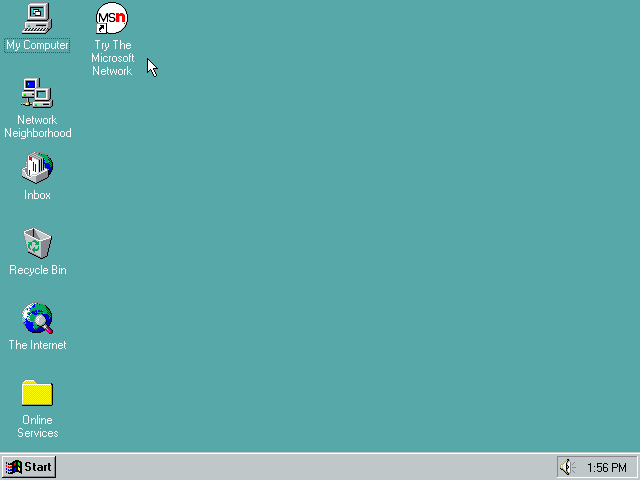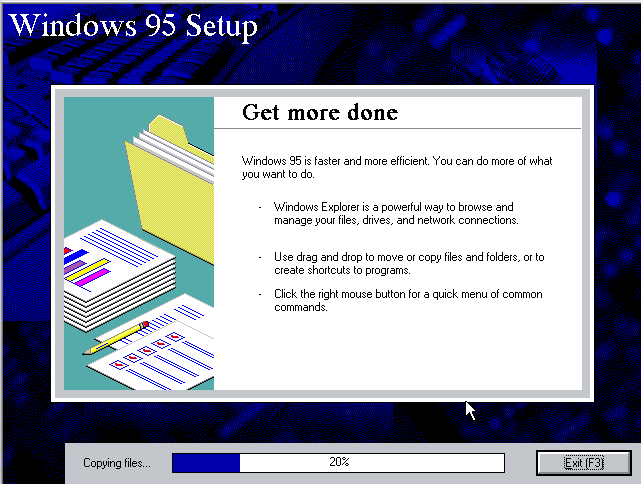Nov 01, 2017 Windows 95 OSR 2.x boot floppy image. Windows 95 OSR2 Boot DIsk Item Preview. ISO IMAGE download. Download 1 file. The first thing that I was gonna do is to burn the 'WINDOWS 95 B.iso' on the CD.However that image is not bootable.The file 'boot95b.exe' probably contains the files for the boot diskette,but I don't have the floppy drive in my computer.And the file 'Windows 95 Boot Disk.img' is something for what I am not really sure what it should be.Boot. Win95 Boot Disk Iso Download. By brimeasnami1980 Follow Public. Windows 98 SE Update (FE To SE) Windows 98 Second Edition (Retail Full) Free Win 98se Boot Disk; Windows 98 was a GUI based operating system that was released by Microsoft in 1998. It was released as a part of the 9x series of the windows operating system which included its.
- See Full List On Winworldpc.com
- Windows 95 Boot Cd Iso Download
- Windows 98 Second Edition (Retail Full)
Windows 95 offered, at long last, a well designed document-oriented desktop shell that worked much like the 1984 Macintosh Finder. It also included a new way of finding installed applications through a 'Start' menu. And it included the same networking abilities as Windows for Workgroups.
It integrated the ability to run 32-bit applications similar to Windows NT or Windows 3.1 with Win32s. It no longer ran on a separate DOS product. But Windows 95 was not a pure '32-bit' OS: It was still based around the framework of Windows 3.x, 2.x and 1.x. It still ran on top of DOS, but bundled its own special 'Windows 95' DOS (AKA MS-DOS 7). It could even still make use of DOS drivers. The 95 architecture was continued with Windows 98.

Most 95 CDs are NOT BOOTABLE. If a download does not include a boot floppy, please see Microsoft Windows Boot Disks
If the listed serials below do not work for a specific release, please see the Serials thread
You may also override the install type (no serial needed) by creating a file name MSBATCH.INF with the lines '[Setup]', and then 'ProductType=1', placing that in the Win95 setup folder, and then running setup.
Screenshots

Release notes
Windows 95 OSR2 ('B' version) added support for FAT32. It bundles IE 3, Personal Web Server, and MS-DOS '7.1'.

OSR2.1 is identical to OSR 2, but includes a seperate USB update installer, that adds the ability to use USB devices. Installing the downloadable USB update brings any OSR 2 system to the level of 2.1.
The OSR 2.x media was ONLY available from OEMs. It was not sold retail.
Installation instructions
Important: Windows 95 CDs are NOT bootable, and require an appropriate Windows 95 Boot Floppy. (A 98FE or 98SE disk will also work fine)
To speed up installation, and to avoid numerous problems, copy the win95 folder to a folder on the hard drive (such as c:win95) and then run setup from there.
Windows 95 was a GUI based operating system which was released by Microsoft in 1995. It was released as a part of the 9x series of the Windows operating system and was the first operating system that was released as a part of the 9x series of Windows operating systems. Windows 95 was released in both 32 and 16-bit versions and it was based on the Disk Operating System (DOS) which was a Command-Line operating system developed by Microsoft. Windows 95 was released on the 15th of August in the year 1995 and was put on sale worldwide on the 24th of August in the same year.
License / Product Key
Free Trial
File Size
411MB / 62MB
Language
English
Developer
Microsoft Inc.

Development of Windows 95 ISO
Windows 95 was marketed extensively by Microsoft and it brought along loads of features that we still see in Windows operating systems today. Some of these features are the Start button which opens up the start menu as well as the taskbar present in the bottom of the screen. Windows 95 also introduced new ways of navigating the Windows 95 operating system.

The major updates that were seen on Windows 95 when compared to the earlier versions of Windows like Windows 3.1 or earlier are the Graphical User Interface updates as well as the ability to simply plug and play certain devices without going through a long hardware drivers installation process. Some changes were also made on the very core of the Windows 95 operating system. Unlike older versions of Windows, Windows 95 moved from a 16-bit architecture which was cooperatively multitasked to a newer 32-bit architecture which was pre-emptively multitasked. All of these improvements were even further improved by its successor, the Windows 98 operating system which was released in the year 1999. Finally, the support for Windows 95 expired on the 31st of December of the year 2001. By then, Microsoft had released numerous other windows platforms like the Windows 98, Windows ME and the well known Windows XP.
User Interface of Windows 95 ISO
Windows 95 had a completely new design for its shell which was based on the Windows 3.1 desktop. The newer shell was made around the metaphor of the top of a desk where the user works. This was called the desktop. This desktop shell contained files, shortcuts to utilities and other apps as well as folders which can contain files and other folders inside them. The desktop was used in every Windows GUI operating system since then and it is being used today in modern Windows operating systems like Windows 8 and Windows 10.
See Full List On Winworldpc.com
The difference between the desktop in Windows 3.1 and the Windows 95 desktop is that in Windows 3.1 which was the predecessor of Windows 95, the desktop displayed the icons of the applications that were currently running on the system. Whereas in Windows 95, the taskbar was introduced which contained the icons for currently running applications. This made navigating to other applications easier as users would not have to go through the desktop. Then taskbar also served as a notification panel by displaying notifications in the notification area on the bottom right of the screen.
The taskbar also contained the new Start button and when the start button was clicked, it displayed the start menu which contained the list of installed applications on the Windows 95 operating system. It was provided as a shortcut to open documents and programs both and was an alternative way of opening programs at the time. The start menu succeeded the Program Manager which was the way of opening applications before the start menu was introduced and it inherited the hierarchy of applications as was in the Program manager.
Windows Explorer was introduced as the default method of browsing and opening files in Windows 95. It succeeded the File Manager application which was used in previous versions of Windows to open files and browsing through them.
The UI appeared to be significantly unique from earlier forms of Windows, however. its structure language did not have an uncommon name like Metro or Material Design has in today’s UI. The subproject inside Microsoft to build up the new shell was inside known as “Stimpy”.
In the year 1994, two design heads at Microsoft, Mark Malamud and Erik Gavriluk drew closer Brian Eno to form music for the Windows 95 project. The outcome was the six-second start-up music-sound of Windows 95 and was regarded as the iconic Microsoft Sound.
At the point when Windows 95, as well as the NT 4 frameworks, came out, Internet Explorer 4 accompanied a discretionary Windows Desktop Update, which changed the shell to give new highlights incorporated Internet Explorer, for example, Active Desktop (which permitted Internet substance to be shown on the work area) and extra updates to Windows Explorer such as going to a website by typing its URL into the address bar in Windows Explorer.
Features of Windows 95
Windows 95 was based on a completely redesigned area for working on and being productive as well as for entertainment purposes. It built a lot upon its predecessors like the Windows 3.11 operating system with the new UI elements like the start button as well as the redesigned desktop which served as a digital equivalent of a workplace with its files and folder structure. These are some of the features which were introduced on or improved a lot in Windows 95 and to a level that we are still using these features after over two decades later.
- Using devices directly with plug and play: Windows 95 brought upon the feature where any device would be installed directly without the user’s interference. It eliminated the use of jumpers which was the way new hardware elements were installed to the Windows system before Windows 95.
- The Introduction of Device Manager: With Windows 95, the developers of the operating system introduced a utility called device manager which was a slick way to see the devices connected to the system and update their drivers or install new drivers quickly without going through the command-line interface.
- 32-bit support: Windows 95 kickstarted the era of 32-bit computing on Windows which helped to build more faster applications meant to be run in a 32-bit environment instead of a 16-bit one.
- The Windows Registry: The Registry utility on the Windows 95 is unchanged over the years. Only because it is so efficient. It had brought down the application-specific configuration files down to just two simple registry files that could be edited and backed up easily.
- Right Click support: Windows 95 had complete support for the right mouse button which helped during writing as well as manipulating text. The right-click context menu was introduced in Windows 95 and is still being used today due to its effectiveness.
System Requirements for Windows 95 ISO
Windows 95 took a major leap forward over Windows 3.1 and started putting demands on system requirements including a 386 or 486 processor and 4 to 8 MB of RAM.
- Personal computer with a 386DX or better processor (486 is recommended)
- 4 MB of memory (8 MB is recommended)
- Hard disk space: 35 to 40 MB (to upgrade). This varies based on which features you select to install.
- Hard disk space required to install Windows 95 on a clean system: 50-55 MB. Can vary based on which features are selected for installation.
- 1 x 3.5-inch high-density floppy disk drive
- Video: VGA or higher resolution (recommended: 256-color SVGA)
Windows 95 ISO download: Windows 95 free download - ISORIVER
Windows 95 was a GUI based operating system which was released by Microsoft in 1995. It was released as a part of the 9x series of the Windows operating
Price Currency: USD
Windows 95 Boot Cd Iso Download
Operating System: Windows 95
Windows 98 Second Edition (Retail Full)
Application Category: OS
